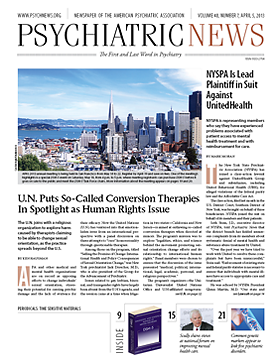A study that’s being characterized as the largest genetic study of psychiatric illness ever undertaken could someday result in psychiatric disorders being classified on the basis of biomarkers, rather than descriptive syndromes.
The Psychiatric Genomics Consortium was formed in 2007 to conduct meta-analyses of genomewide association studies (GWAS) for psychiatric disorders. The consortium’s Cross-Disorder Group presented its first publication online February 28 in the Lancet, detailing the results of efforts to examine the possibility of common genetic markers or single-nucleotide polymorphisms (SNPs) that might affect susceptibility to autism spectrum disorder, attention-deficit/hyperactivity disorder, bipolar disorder, major depressive disorder, and schizophrenia.
They started by searching the National Human Genome Research Institute GWAS catalogue as of September 2012, to identify all previous reports of genomewide significant association for any of the five disorders. Then, in a meta-analysis in which they scanned the genome of 33,332 patients and 27,888 controls of European ancestry, they identified four risk loci that have significant and overlapping links with all five diseases: regions on chromosomes 3p21 and 10q24, and SNPs in two genes that make components of channels that regulate the flow of calcium in brain cells (CACNA1C, linked to bipolar disorder and schizophrenia in previous studies, and CACNB2).
“This analysis provides the first genomewide evidence that individual and aggregate molecular genetic risk factors are shared between five childhood-onset or adult-onset psychiatric disorders that are treated as distinct categories in clinical practice,” explained Jordan Smoller, M.D., Sc.D., a psychiatric geneticist at Massachusetts General Hospital and one of the study’s lead researchers, in a news release coinciding with the study’s publication. Smoller characterized the results as “significant progress…in understanding the genetic risk factors underlying psychiatric disorders.”
The calcium-channel results were particularly intriguing. “Alterations in calcium-channel signaling could represent a fundamental mechanism contributing to a broad vulnerability to psychopathology,” said the researchers, who also noted the potential for such channels to be therapeutic targets for psychiatric illness.
The group also pointed out that their findings parallel those from other medical specialties: “Most notably, GWAS of autoimmune disorders have shown extensive overlap in genetic variants that affect a diverse range of diseases, including rheumatoid arthritis, celiac disease, multiple sclerosis, systemic lupus erythematosus, psoriasis, Crohn’s disease, and type-1 diabetes.”
The implications of the study—for disorder characterization and for treatment—are exciting. “These important findings indicate that fundamental alterations in brain development and biology can confer vulnerability to various types of mental disorders…,” Jeffrey Lieberman, M.D., president-elect of APA told Psychiatric News. “Overall, the study provides an important new clue about the etiology and pathogenesis of mental disorders.”
APA President Dilip Jeste, M.D., also expressed hope about the future potential of the study’s findings. “Research of this type would help in the development of future diagnostic systems in psychiatry that are based on validated biomarkers…This important study is one step in that direction.”
In an editorial accompanying the study report, Alessandro Serretti, M.D., Ph.D., and Chiara Fabbri, M.D., both of the Department of Biomedical and Neuromotor Science at the University of Bologna, Italy, hailed the quality of the effort. “The main innovative contribution of the present study is the combination of qualitative and quantitative analyses of the shared genetic features associated with vulnerability to these five disorders,” they said, while also noting that the reliability of the results was strengthened by the investigators’ “accurate methodological design.”
The study was supported by a grant from the National Institute of Mental Health. ■

